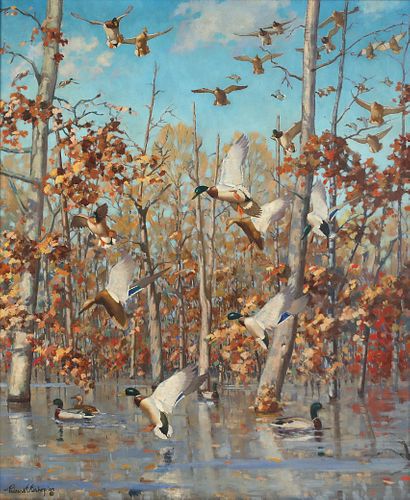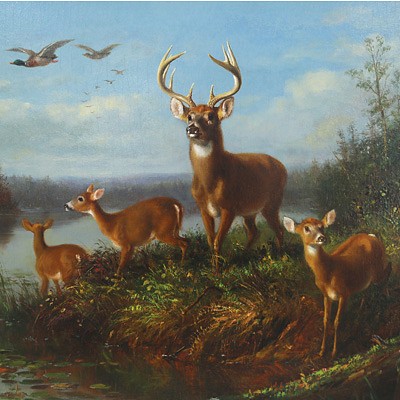Richard E. Bishop (1887-1975), Prairie Wings
Lot 152
About Seller
Copley Fine Art Auctions
20 Winter Street
Pembroke, MA 02359
United States
Founded in 2005, Copley Fine Art Auctions is a boutique auction house specializing in antique decoys and American, sporting, and wildlife paintings. Over the course of the last two decades, the firm has set auction records for not only individual decoy makers, but also entire carving regions. Copley...Read more
Categories
Estimate:
$10,000 - $15,000
Absentee vs Live bid
Two ways to bid:
- Leave a max absentee bid and the platform will bid on your behalf up to your maximum bid during the live auction.
- Bid live during the auction and your bids will be submitted real-time to the auctioneer.
Bid Increments
| Price | Bid Increment |
|---|---|
| $0 | $50 |
| $1,000 | $100 |
| $2,500 | $250 |
| $5,000 | $500 |
| $10,000 | $1,000 |
| $25,000 | $2,500 |
| $50,000 | $5,000 |
About Auction
By Copley Fine Art Auctions
Feb 24, 2023
Set Reminder
2023-02-24 10:00:00
2023-02-24 10:00:00
America/New_York
Bidsquare
Bidsquare : The Winter Sale 2023, Day 1
https://www.bidsquare.com/auctions/copley/the-winter-sale-2023-day-1-11939
Lots 1-337 Copley Fine Art Auctions cinnie@copleyart.com
Lots 1-337 Copley Fine Art Auctions cinnie@copleyart.com
- Lot Description
Richard E. Bishop (1887-1975)
Prairie Wings, 1945
signed and dated "Richard E Bishop '45 ©" lower left
oil on canvas, 30 by 25 in.
signed, titled, and dated on back
An edition of "Prairie Wings" by Edgar M. Queeny, published by Ducks Unlimited in 1946 accompanies the lot.
In 1946, Edgar Queeny published "Prairie Wings" through Ducks Unlimited. It is now one of the most important books on waterfowl ever written. He studied the landing patterns of birds over Wingmead, his 14,000 acre property in Arkansas, which had three named green tree reservoirs: Wingmead, Paddlefoot, and Greenwood. Queeny was an active patron of Bishop's and partnered with the artist for the many illustrations throughout the book, including the color frontispiece.
Queeny wrote, "Dick's paintings and etchings of wildfowl are outstanding because he is not only a superb artist but a topnotch engineer! As a result of his engineering training and his understanding of aerodynamics, mechanics of flight and the anatomy of birds came as second nature to him - the results are portraits of birds as they really fly!"
Bishop's original drawings and Queeny's photographs from "Prairie Wings" were donated by Thomas K. Figge to the John L. Wehle Gallery of Sporting Art at the Genesee Country Village & Museum in 1986, where they remain in the permanent collection.
This famous frontispiece for "Prairie Wings" comes from the collection of Joseph N. Pew Jr., the Sun Oil heir, philanthropist, and avid sportsman. He hunted and fished in Nova Scotia, started the Pew Charitable Trusts, and likely encountered Edgar M. Queeny in New York's Links Club, where both were members.
Provenance: Joseph N. Pew Jr. Collection
Alberta Hensel Pew Baker Collection, Chester, Nova Scotia
Private Collection
Literature: Edgar M. Queeny, "Prairie Wings: Pen and Camera Flight Studies," New York, NY, 1946, frontispiece, XIII, p. 225.Please email condition report requests to leah@copleyart.com. Any condition statement given is a courtesy to customers, Copley will not be held responsible for any errors or omissions. The absence of a condition statement does not imply that the lot is in perfect condition.Condition
- Shipping Info
-
Shipping info
Copley does not offer in-house packing or shipping. For clients who require shipping, please complete the Shipping Release Form and return it with your payment. The form includes a list of shippers we frequently work with.
-
- Buyer's Premium



 EUR
EUR CAD
CAD AUD
AUD GBP
GBP MXN
MXN HKD
HKD CNY
CNY MYR
MYR SEK
SEK SGD
SGD CHF
CHF THB
THB















